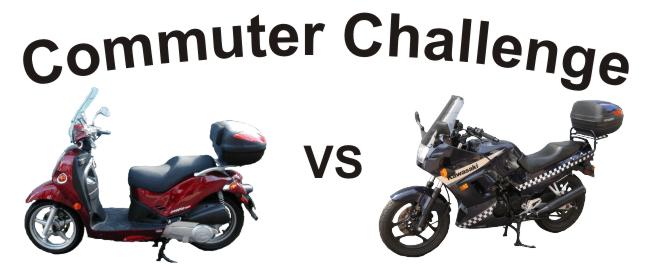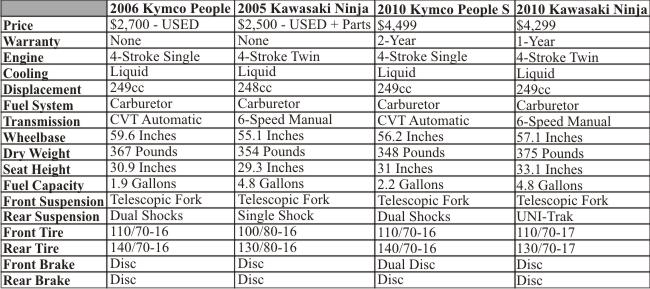This all started because (apparently) people love a competition, comparison or challenge and I love a project, especially a powered-two-wheeled sort of project. Which is a better commuter – a scooter or a motorcycle? I have been asked this question more times than I can count and it has been the subject of discussion and downright argument at various shops, garages and bars. Yeah – usually bars. This is an attempt to answer that question.
I make no secret of my affinity for scooters (this IS the Just Gotta Scoot website after all) but I have been riding motorcycles for longer and still own a few bikes. To make this a relatively valid comparison, I wanted to begin with two machines of similar size and cost. I own both the 2006 Kymco People 250 and the 2005 Kawasaki Ninja 250 utilized here. I wanted both machines to be set up with commuting as the primary function. I commute at least 24 miles (round trip) six days per week and sometimes need to cover upwards of a 100 miles in a day. Most days I have the option to select city streets, freeways, or surface roads of varying speeds. I live in Minnesota and that means months of miserable weather. I have good cold weather equipment and will ride in the winter if the roads are clear. I don’t ride on icy, snowy roads.
The Machines
Let’s start with a comparison of the specifications of the machines. The chart below includes the two machines utilized here as well as their new (2010) replacements:
Looking only at the specs, the machines aren’t that different, they ride on 16 inch tires, have similar engine sizes, weight and seat heights. Of course they are really VERY different machines that go way beyond their specifications.
Kymco People 250
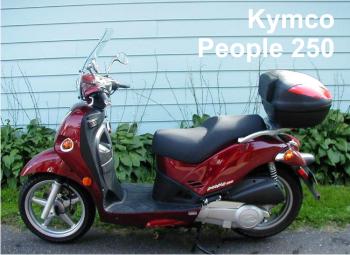
Storage on the People 250 is very good. There is a hook on the inside front legshield and I often hang re-usable fabric shopping bags 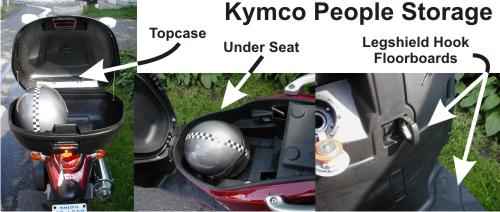
The Kymco People 250 is comfortable and easy to mount. The flat floorboards and step-through design mean that “swinging a leg” over the machine is NOT a mandatory part of getting on and off. The automatic transmission is a commuter’s dream come true. No matter the traffic conditions, the People 250 is easy to operate and responsive. Protection from the elements is quite good – when riding I feel sheltered from the shoulder on down when in motion. Road grime and rain hardly bother me. Acceleration is strong and I have no issue at all keeping up with traffic. From about 60 MPH to the top of 80 MPH acceleration is slow. Not easy to pass a big truck when doing 65 MPH uphill on the freeway. Luckily, that situation almost never comes up while commuting.
Kawasaki Ninja 250
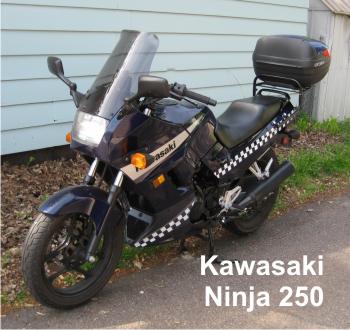
Often touted as a great beginner’s bike, the Ninja 250 is an extremely capable machine that is loads of fun to ride. It is certainly sporty in looks and riding position, but not extremely so. This bike is not the first “Ninjette” (or baby Ninja) in the family – my wife Beverly owned one a few years back.
Beverly had a Ninja and a Honda Rebel 450 as her first bikes when she got her motorcycle endorsement. Both were very fine machines, but she never really “took” to motorcycles and now rides scooters instead.
The Ninja in its purely stock form could certainly be pressed into service as a commuter, but I wanted to set the bike up to be specifically focused on this task.
Time to get out the tool box (and chequebook). In order for the Ninja to be comfortable for me, it needed a taller windscreen, risers for the controls and some luggage capacity. I will go into more depth about this conversion in a separate article on a different (motorcycle focused) venue. Suffice to say that my Ninja 250 is now a very nice commuting machine.
There is no “native” storage on a stock Ninja 250. A lot of people who commute on motorcycles make due with what they can carry on their own body by means of a messenger bag or backpack. Some will add soft luggage such as a tank bag, tail bag or saddle bags. None of these would work for me as I needed hard, lockable storage that could be left on the bike. In addition to that storage, I do often carry a messenger bag during my commute.
The Ninja 250 has a high-revving twin-cylinder liquid-cooled engine that gets power to the back wheel by means of a chain through a 6-speed manual transmission. Like most any other motorcycle, this means shifting – and sometimes lots and lots of shifting – during my commute. In most circumstances this isn’t a problem and I quite enjoy it. In stop-and-go-freeway-crawling shifting can get tedious quickly. The Ninja 250 redlines at something like 13,000 RPMs and it is necessary to be in the upper end of the range to get any kind of acceleration out of it. If that sounds like a chore I didn’t mean it that way, it’s a blast to wring out that bullet-proof little motor. Running at around 7,000 to 8,000 RPMs in sixth gear at freeway speeds does take some getting used to. Just wind it out and let it do it’s thing. The speedometer on my Ninja is (like the Kymco People) optimistic. It reads close to 10% faster than actual speed. The top speed I’ve verified on GPS was 93 MPH – much faster than I’d EVER need to go on my commute. Highway speed passing is no problem as long as one downshifts (often two gears) and revs out the motor. Fuel economy is very good at 55 MPG – 65 MPG. My average during my commute is 58 MPG.
The Challenge
I came up with a scoring system based on relative performance in each category. The “perfect” score in each category is based on suitability as a commuter.
Price/Value – This is the top category and points are based on availability, cost of comparable machines and any modifications needed. The Ninja did better than the People because even with all the extra accessories installed the total price is still lower.
Reliability – Properly maintained, neither machine will let you down – a tie.
Maintenance – The People did better here than the Ninja with fewer required maintenance tasks and ease of performing them. Cleaning the carburetors on the Ninja was a chore – mostly because of how tough they are to get at. It’s pretty simple on the People.
Insurance – Both machines have the same coverage with the same rider, but the People costs less than the Ninja.
Storage Capacity – Even with the addition of a topcase, the Ninja just can’t compete with the People in this category.
Comfort – Close call, but the People just edged out the Ninja because of the step-through design and upright seating position.
Ease of Operation – For commuting, automatic wins out over manual transmission.
Fuel Economy – Dead even – both machines get class-leading mileage.
Fun Factor – Sorry Kymco People, the Ninja is just plain more fun to ride.
I rode both machines a great deal over several months. Sometimes I would alternate every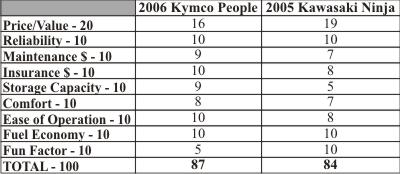
When I walk into the garage in the morning with both machines looking at me, begging to be ridden, I usually go to the People if I have a lot to do that day and don’t know what kind of traffic I’ll be in or what I might have to haul with me. On days when I could get on a faster road without a lot of pressure for time, I’ll hop on the Ninja.

